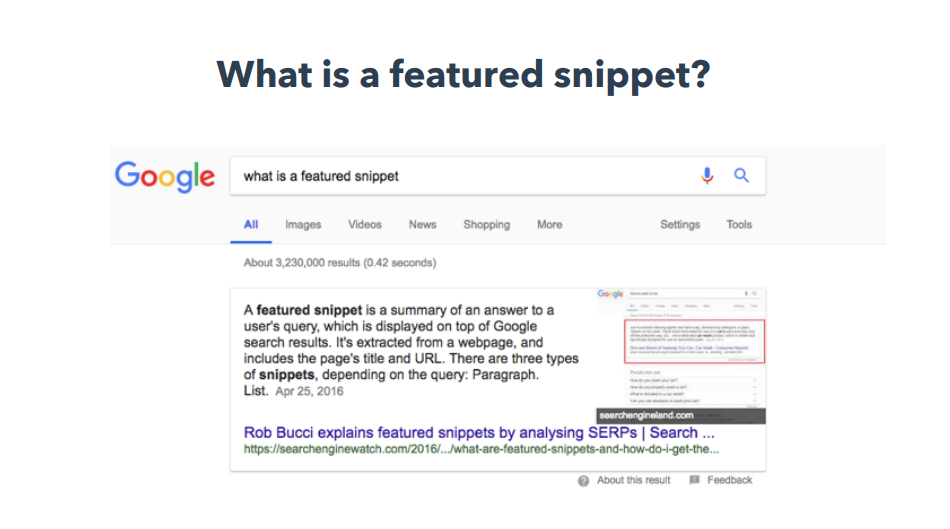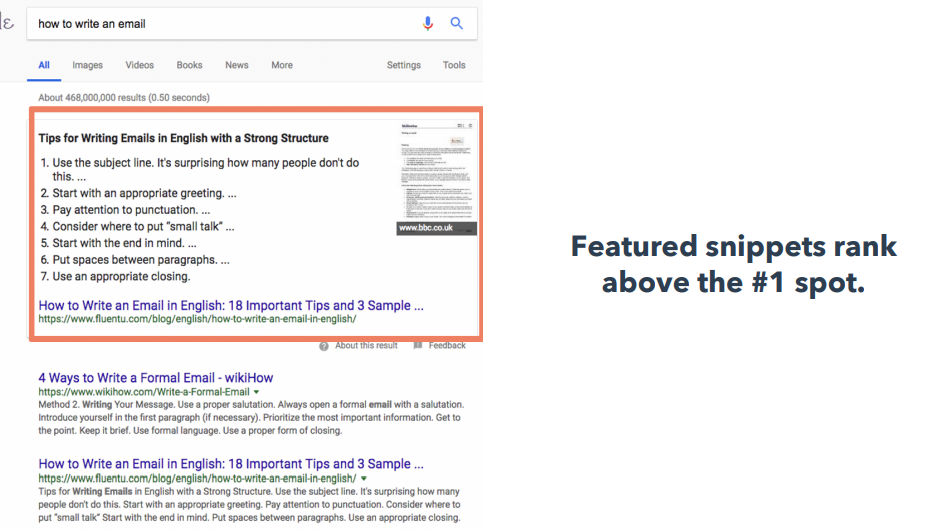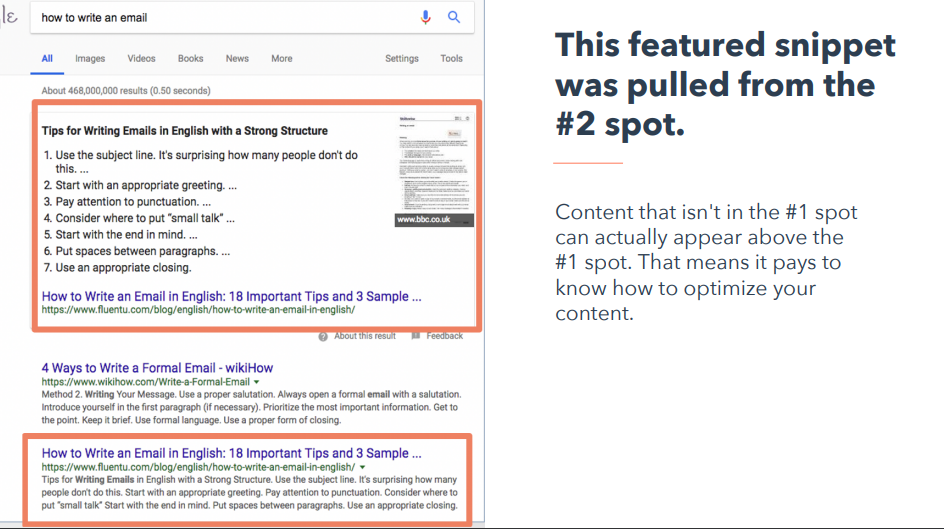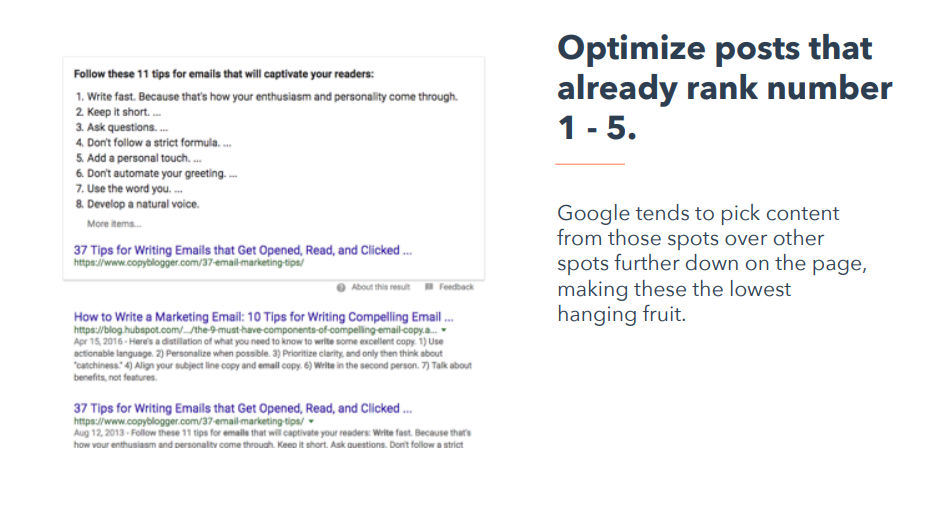Google is getting better at understanding the intent of searches, and wants to provide searchers with an IMMEDIATE response to their queries. This answer will be so quick, that they won’t have to look through search results. This answer is in the form a featured excerpt.

What is a featured snippet exactly? Ask Google
Google says that a featured snippet summarizes the answer to a query and is displayed at the top of Google’s search results. It is a snippet that’s taken from a website and includes the title and URL of that page.
What’s that? Featured snippets appear ABOVE the top-ranked spot! It’s hard enough to be ranked #1! 🙂
It’s more complicated than this. Google will pull featured snippets from a page on the first page of search results. However, the page which wins the featured result is not necessarily the top result. It is possible for content that does not rank #1 to appear above the #1 position.

It is important to understand how to optimize content for organic search, including the featured snippets.
Three reasons are there for you to care about featured excerpts. One of the reasons you should care about featured snippets is that they appear for many terms that your customers use to search. Google will often serve featured snippets in response to “Who, What and When” questions, the same types of questions your content is aimed at answering. Also, they tend to appear for popular terms and broad topics.

Two, featured snippets are often the first results for voice searches. In fact, in 71% of the search queries that resulted in featured snippets for desktop searches, featured snippets were displayed first on voice search results. Google and Bing both predict that voice searches will account for 50% of mobile searches in 2020.
Three: You will not be able to attract customers if you do not have a strategy that is effective in capturing the changes made by your customers when they are searching. The search is changing, and featured snippets are now a major factor in organic search traffic across desktop, mobile and voice searches. You should adapt to your customers’ needs.

How can you optimize your blog for Google’s featured excerpt?
You can increase your chances of capturing the featured excerpt by optimizing posts on your blog that are already ranked in the first five positions in search engine results. Google will often choose content in those positions over spots lower down the page. This is the easiest way to get featured snippets.
You’ll first want to check Google Search Console and see if any of your blog posts are ranking in the top five positions for any important keywords. List these posts and the keywords that they rank for.
Open a new window incognito in your browser, and then search for the keyword you want to test if Google will show a featured snippet. Checkmark the posts which are ranking for featured snippets. Even if there ISn’t a featured result for the query, you should still check back later.
Next, optimize the posts for the featured excerpt. Google prefers content which is concise and simple. The most important thing is to format your content correctly. Google uses an algorithm for extracting content from snippets. If the text isn’t properly formatted, it won’t understand what’s happening and will skip this result.
Make sure that your list is clearly labeled and includes headers if the featured snippet for your keyword is a LIST format. Add a list version of the larger blog post to the top of the webpage to help Google identify it as a snippet. If you can, list seven steps or less – Google will stop you at eight steps for the snippet.
The same can be done for a featured excerpt in PARAGRAPH format. Write a brief answer to the query you want and place it in a module that is above the rest your post. Google prefers featured snippets that are less than 50 words. Take note of the current snippets to get an idea of what Google is looking for. But don’t copy them word for word. Try to IMPROVE what is already there.
After you have made the changes, send Google the URLs so that they can be crawled again. The number of clicks on the results page and the click-through rates will give you a good idea of the success. You can also measure the organic traffic generated by your blog post. Because snippets by Google are an algorithmic feature, the results may vary day-to-day. We recommend that you track your snipp.
Blog resources
- Tool: Google Structured Data Testing Tool
- Tool: Google Rich Results Test
- Tool: Schema Markup Generator
- Website: Schema.org
- Tool: WordPress Structured Data Plugins
- Tool: Google Structured Data Code Lab
- Blog post: JSON-LD for Beginners
- Guide: Google Search Gallery
- Article: A reintroduction to Google’s featured snippets
- Blog post: Mega-SERP: A Visual Guide to Google
- Blog post: Your Cheat-Sheet for Compressing Images
- Blog post: How to Resize an Image without Losing Quality
- Blog post: Image Alt Text: What It Is, How to Write It, and Why it Matters to SEO
- Blog post: A Comprehensive Guide to Local SEO in 2024


















